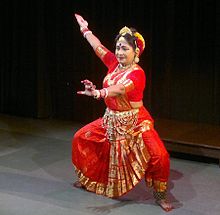गौड़ीय नृत्य

गौड़ीय नृत्य ( बांग्ला: গৌড়ীয় নৃত্য, IAST: Gaur̤īẏa Nṛtya ) या गोउड़ीयो नृत्यो, एक बंगाली नृत्य परंपरा है। [1] [2] [3] इसकी उत्पत्ति बंगाल में गौड़ से हुई, जिसे गौर के नाम से भी जाना जाता है। [4]
श्रीमती महुआ मुखर्जी द्वारा इसका पुनर्निर्माण किया गया है। [3] [5] यह संस्कृति मंत्रालय द्वारा एक भारतीय शास्त्रीय नृत्य के रूप में मान्यता प्राप्त है, [6] संगीत नाटक अकादमी द्वारा भी मान्यता प्राप्त है, लेकिन इसका अध्ययन भारत के संस्कृति मंत्रालय से छात्रवृत्ति के लिए पात्र है। [7] पुनर्निर्माण का विद्वानों का स्वागत सावधानी से लेकर संदेह तक है।[8] [9] [10]
- ↑ Roma Chatterji (2005). Folklore and the Construction of National Tradition Archived 2018-02-12 at the वेबैक मशीन. Indian Folklife 19 (Folklore Abroad: On the Diffusion and Revision of Sociocultural Categories): 9. Accessed January 2014. "a classical dance tradition that has vanished from the urban areas".
- ↑ "West Bengal Tourism: Dance". Department of Tourism, Government of West Bengal. 2011. मूल से October 21, 2013 को पुरालेखित. अभिगमन तिथि January 11, 2014.
- ↑ अ आ Bharatram, Kumudha (April 9, 2011). "Dance of the ancients". The Hindu. अभिगमन तिथि November 15, 2013.
- ↑ Mukherjee, Mahua (2000). Gaudiya Nritya (Bengali में). Kolkata: The Asiatic Society.
- ↑ Rajan, Anjana (December 26, 2006). "The wheel has come full circle". The Hindu. मूल से November 8, 2012 को पुरालेखित.
- ↑ "Gaudiya Nritya". INDIAN CULTURE (अंग्रेज़ी में). अभिगमन तिथि 2022-01-25.
- ↑ "Scholarship to Young Artistes, 2005". Ministry of Culture. Government of India. मूल से October 21, 2013 को पुरालेखित.
- ↑ "Feet forgotten and found". www.telegraphindia.com. अभिगमन तिथि 2022-01-25.
- ↑ Leela Venkataraman (2006). Negotiating the Extremes: dance. India International Centre Quarterly, 33 (1): 93-102. (सब्सक्रिप्शन आवश्यक) "one may have reservations about the classical dance repertoire visualised by [Mukherjee]".
- ↑ Roma Chatterji (2005). p. 9: "Mukherjee tries to reconstitute a Bengali aesthetic within the perspective of pan-Indian civilisation".
